| Spotlight
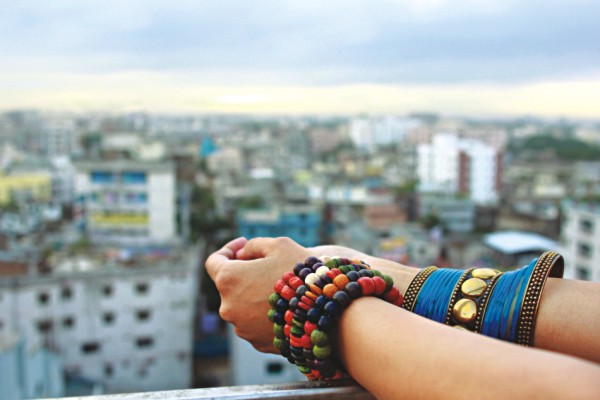
Celebrating Year 1419
The Youth Embrace Culture
Promiti Prova Chowdhury
Photos:Kazi Tahsin Agaz Apurbo
Cover Model: Anika Hossain
Happy First Baishakh! This is how the students belonging to different nationalities, including American, African, Indian, Paraguayan, Pakistani, Romanian, and many more, are greeting each other on the occasion of Pahela Baishakh 1419, at the University of North Texas (UNT), USA.
The proud President of the Bangladesh Student Association (BSA) at UNT, Reasa Binte Ikram Bristee, shares, “In 2010, I arranged a different kind of Pahela Baishakh with a group of friends from 'World Echoes', which is a multicultural club of UNT. It provides platform to different races of students to represent their ethnic culture. My purpose was to promote this wonderful occasion of ours to students here. Back then I was just a member of BSA-UNT, but I managed to convince the President of World Echoes and took a group of students to the Dallas Baishakhi Fair and introduced them to our Baishakhi elements like, pitha-puli, phuchka and the ingredients used in them. They were all dressed in the traditional colours of white and red. They loved the pithas. Some of them even said that the puli pitha looks like a piece of art and they feel bad to break it and eat it!”

The mouth-watering Baishakh delicacies.
This is what happens when students opt for cultural exchange programmes today. Bristee adds, “Obviously Pahela Baishakh is a trademark of our Bengali culture and I wanted them to feel the spirit of it, not take it as a mere celebration. Now, when they wish us and ask us (the Bangladeshi students) to get them deshi fatuas for the occasion, it feels great to see that Baishakh exists here on campus, where a few years ago no one had even heard of it.”
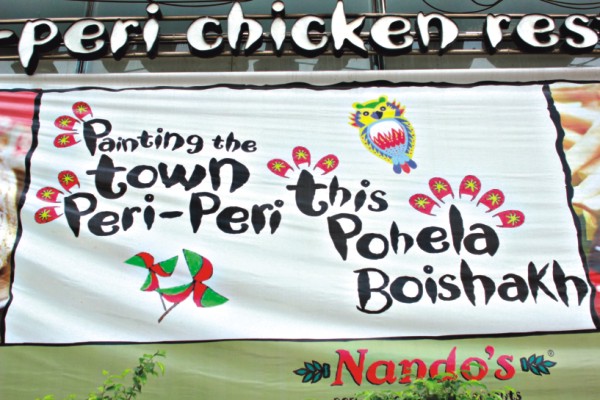
One of the many promotional offers attracting the young crowd.
Having so many colours and diversifications in terms of our cultural elements, the youth today implement a lot of their innovativeness, even when it comes to celebrating Pahela Baishakh. For instance, the young women nowadays like to make full use of the promotional offers, put forward by the leading beauty salons in Bangladesh, which starts from getting your hair done to wearing the traditional ek pech sari, right at the break of dawn. Of course, one simply cannot miss the stone washed jeans, the cargos and even designer jeans adorned with panjabis and kurtas, not to mention wearing an improvised dhuti with elastic for safety! The new styles in clothes and fashion this season simply cannot be missed, not to mention the diet that also becomes slightly crazy! Where else will one find chunks of Hilsha over Pizza, fast foods catered in a shanki? One can go on about the fun elements and latest ways that young people bring in, to celebrate Pahela Baishakh.
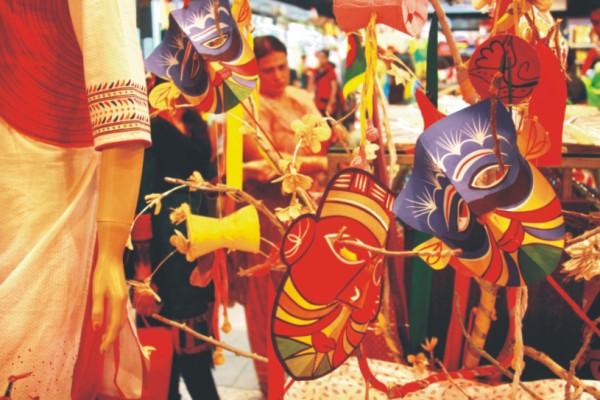
Fashion houses get swarmed with young students.
Sadia, a student of Media Studies and Journalism thinks that on the day of Pahela Baishakh, everyone suddenly turns 'Bengali!' “Everybody is eager to 'show' their Bengali-ness on this day," she says. "Should not this be a daily practice? Pahela Baishakh is not only about wearing red and white, eating expensive hilsha-pantha, roaming around the city with friends. It is a day when we let go of our past sufferings, miseries and sins. We embrace a new dawn and promise to be purified as a better citizen of Bangladesh. Therefore, we should hold this strength and learn to grow as a nation with due respect to all the ethnic cultures we have inside the country. Our appearance does not define who we are, our activities do.“
| |
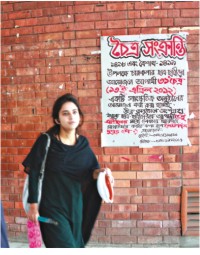 |
| |
Students getting ready to celebrate on campus. |
However, culture is always in a state of flux and who else will carry it forward but the youth of today. The culture of the youth today is shaped by the young people's access and exposure to the outside world, which they also make a part of their daily lives and culture. “On Pahela Baishakh, I would probably be wearing jeans with a red and white top, going to an event posted on Facebook, to meet my friends at a fast food chain restaurant for dinner,” says Adiba, an English Literature major.
Rebeka Badiuzzaman, an English Language Training Professional, working at Saint Jhon's Tutorial, a centre specialised in teaching IELTS, says, “It is important to understand that there exists a positive intention amongst the youth and that is what matters. In terms of celebrating Pahela Baishakh, if the celebration is done in a healthy way, it would definitely be encouraged. Culture, I believe, is something that one does and something one should do.”
Many call this an impact made by 'globalisation,' which is a new form of culture that knows no boundaries and is spreading everywhere. Similarly, the Pahela Baishakh celebrations are also going through certain changes which are in turn influenced by the elements of globalisation. Imtiaz Ahmed Chowdhury, a musician and Lecturer at the University of Liberal Arts, Bangladesh (ULAB) says, “I think the youth these days are so used to a 'fused' culture, they probably cannot distinguish between the elements of the east and that of the west properly. The reflection of this can be found in fashion, music and even verbal use of language. However, a lot of debatable 'western' elements in this fusion are not really western at all. For example, the existence of ethnic art or jewellery can be traced back to the 'American' culture, but that itself has been transferred to the US from the Native-American or the African-American cultures."
At the end of it all, it is a wonderful feeling, especially when the enthusiastic young people brighten up the streets with their colours, despite the heat and traffic, and celebrate the day like there is no tomorrow!
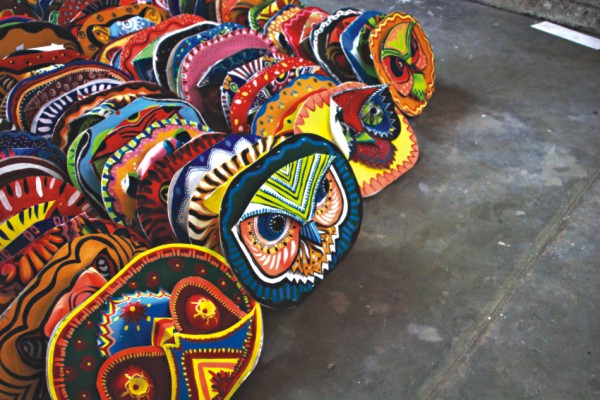
|
